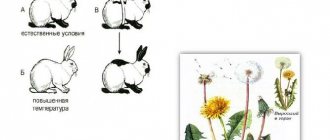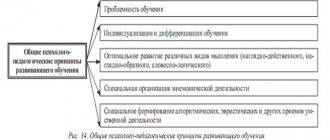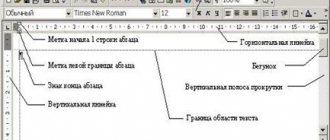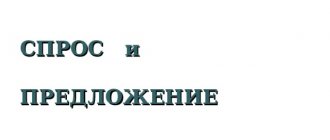The task of modern breeding
Breeding (from Latin selectio - selection) is the science of creating new and improving existing varieties of plants, animal breeds and strains of microorganisms. Selection is the field of practical application of genetics.
This is the need to increase the productivity of plants, animals, microorganisms, the development of new breeds, varieties, strains, which will ensure maximum production of food and other products with minimal costs.
An animal breed or plant variety is a collection of individuals of the same species with special hereditary characteristics (milk yield, productivity, etc.) created by man using artificial selection.
A strain (from German stamm - trunk, family) is a pure culture (offspring of one cell) of microorganisms. From one cell you can get different strains. They will differ in productivity, sensitivity to drugs, etc.
A breed, variety and strain primarily cannot exist independently, without some human intervention. Plant varieties and animal breeds may not always exhibit the same properties as in the area where they were bred.
Characteristic
The main characteristic features of artificial selection are presented in the table.
| Sign | Meaning |
| An object | Individuals, sometimes groups for crossing |
| Raw material | Individual phenotypic characteristics of the organism - thickness and color of fur, size, acuity of smell, etc. |
| Factor | Human actions |
| Place | Artificial conditions - farms, nurseries, special stations, laboratories |
| Time | On average – 10 years for the emergence and consolidation of a new variety or breed |
| Criterion | Human needs, obtaining more productive individuals |
| Source of genetic diversity | Hereditary variability and mutations fixed in the genome |
| Result | Obtaining breeds and varieties useful in agriculture, breeding new strains of bacteria useful for the food and chemical industries. In some cases, for example, during hybridization, new species arise that cannot exist in the wild |
In the course of selection, a person leaves individuals with the best qualities. “Bad” individuals are rejected - sterilized or destroyed.
Basic selection methods
Basic selection methods. Breeding is the science of creating new and improving existing varieties of plants, animal breeds and strains of microorganisms. Methods
Artificial selection
The theoretical foundations of the theory of artificial selection were put forward by the English scientist Charles Darwin. He proved that animal breeds and plant varieties have one common ancestor. They are not independent species. Man formed breeds and varieties according to his own interests, sometimes even to the detriment of animals and plants, reducing their viability.
Artificial selection can be carried out consciously or unconsciously . Unconsciously, man began to carry out selection from the moment of domestication of animals. Modern selection is carried out consciously, based on knowledge of genetics and selection, that is, the laws of inheritance and variability.
Artificial selection can be mass or individual . Mass selection is used primarily for plants. In this case, a person selects seeds and bulbs from plants with the best phenotypic characteristics. Thus, the desired trait is increasingly developed. Mass selection is used for plants, since during the growing season a large amount of seed can be obtained, several harvests per season, etc.
Individual selection is used primarily for animals. Animals are not fertile; offspring cannot be obtained quickly. To improve the breed and varieties for propagation, individual individuals are left and their genotype and phenotype are carefully studied.
Hybridization
This is the process of producing hybrids. It is based on the combination of genetic material from different cells and organisms. Hybrids are obtained only through the sexual process or through the union of somatic cells.
Hybridization can be carried out within one species and is called intraspecific . Intraspecific hybridization can be related or non-related . Hybridization between different species is called interspecific .
Intraspecific hybridization. Inbreeding
Inbreeding or inbreeding (from the English in - in, inside and briding - breeding) is the crossing of organisms that have common ancestors. Inbreeding can be observed in self-pollinating plants and hermaphroditic animals. Depending on the degree of relatedness, it can be more (hard) or less (soft) close. Hard inbreeding is the crossing of mother and son, father and daughter, brother and sister, and soft inbreeding is the crossing of related organisms in the fourth and subsequent generations.
With inbreeding, the homozygosity of the hybrids increases with each generation. Most harmful mutations are found in recessive genes. The consequence of inbreeding is the weakening, even degeneration of the descendants. Severe illnesses and various hereditary anomalies appear.
In breeding, inbreeding is widely used, since it is based on the breeding of pure lines. With the help of inbreeding, breeds are maintained and rare desirable traits are established.
Intraspecific hybridization. Unrelated crossing
Unrelated crossing or outbreeding (from the English out - outside). This is the crossing of organisms that are not closely related. This is the crossing of representatives of different lines, varieties, breeds that belong to the same species. Organisms that have not had common ancestors over the previous six generations are considered unrelated. Used to combine valuable properties of different lines in the offspring. Outbreeding is used to increase the viability of breed or varietal lines and helps prevent their degeneration. With unrelated crossing, one can often observe the phenomenon of heterosis (from the Greek heterosis - change, reincarnation).
Heterosis is a phenomenon according to which the first generation of hybrids from unrelated crossing has increased productivity and viability in comparison with the parent forms. In heterotic organisms, most alleles become heterozygous. Full manifestation of heterosis is observed only in the first generation. Further, the alleles will gradually turn into a homozygous state, the effect weakens.
Widely used in agriculture. Therefore, pure lines are always maintained in breeding work.
Interspecific hybridization
Distant or interspecific hybridization . This is the crossing of individuals of different species. It is a promising method of breeding work. They are carried out with the aim of combining valuable qualities that are inherent in individuals of different species. Using distant hybridization, a hybrid of wheat and wheatgrass was obtained, which has greater productivity and resistance to lodging; rye with wheat (triticale), raspberries and blackberries, etc.
Since ancient times, distant hybridization has been carried out to produce mules (hybrids of a mare and a donkey). Mules are distinguished by high vitality, great strength, and a long life span. A new breed of sheep (a hybrid of merino and argali mountain sheep), bester (a hybrid of sterlet and beluga), etc. were bred.
With distant hybridization, the problem of infertility of interspecific hybrids arises. In hybrids, both males and females can be infertile, either simultaneously or separately. The difficulty in breeding hybrids is that different species have different numbers of chromosomes in sets, so the chromosomes do not separate during meiosis. Even if the number of chromosomes is the same, their structure is different. This also leads to disruption of chromosome divergence and inability to conjugate. Overcoming infertility in animal hybrids is especially difficult.
A method for overcoming the infertility of plant hybrids obtained through interspecific hybridization was proposed in 1924 by G. D. Karpechenko. He developed it by crossing radish and cabbage. These two plants have the same set of chromosomes. The scientist doubled (thanks to polyploidy) the set of chromosomes of the hybrid, that is, two complete sets of chromosomes appeared in the nucleus. The conjugation process began to proceed normally. Each chromosome had a pair.
It has become possible to produce hybrids in animals using cell engineering.
Features of selection of animals and plants
Plants are characterized by sexual and asexual reproduction. In plant breeding, individual and mass artificial selection and various forms of hybridization are used. The sterility of hybrids is overcome by polyploidy. Polyploidy is also used to increase the yield of varieties. Various forms of plants are obtained by grafting.
Vertebrates reproduce only sexually, which significantly limits selection methods. The main methods are individual artificial selection and various forms of hybridization. The phenomenon of heterosis and artificial insemination are widely used in agriculture.
FUNDAMENTALS OF BIOTECHNOLOGY MODERN METHODS OF BREEDING. MUTAGENESIS Lecture 4. – presentation
FUNDAMENTALS OF BIOTECHNOLOGY MODERN METHODS OF BREEDING. MUTAGENESIS Lecture 4
“Selection is evolution guided by the will of man” N.I. Vavilov “Selection is evolution guided by the will of man” N.I. Vavilov
TRADITIONAL METHODS MODERN METHODS OF BREEDING. MUTAGENESIS Lecture 4
Outbreeding - crossing or a system of crossing unrelated forms of the same species Hybridization - the process of obtaining hybrids, which is based on the combination of genetic material of different cells in one Hybrids - offspring obtained from crossing genetically different parental forms Inbreeding - closely related crossing, crossing of organisms that have common ancestors Polyploids - a multiple of the haploid increase in the number of chromosomes Outbreeding - crossing or a system of crossing unrelated forms of the same species Hybridization - the process of obtaining hybrids, which is based on the combination of genetic material of different cells in one Hybrids - offspring obtained from crossing genetically different parental forms Inbreeding - closely related crossing, crossbreeding organisms that have common ancestors Polyploids - a multiple of the haploid increase in the number of chromosomes Dictionary
Selection of parental pairs Traditional methods of selection of higher organisms Hybridization Hybridization Selection Selection Obtaining polyploids Progeny testing outbreeding mass individual inbreeding
Method Animal breeding Plant breeding Selection of parental pairs Based on valuable traits and appearance Based on place of origin (geographically distant) or genetically distant (unrelated) Traditional methods of selection of higher organisms
Method Animal breeding Plant breeding Unrelated hybridization (outbreeding) Crossing distant breeds to obtain heterozygous populations and display heterosis. Infertile offspring Intraspecific, interspecific, intergeneric crossing leading to heterosis to obtain heterozygous populations Mules - a cross between a donkey and a mare shtml Traditional methods of selection of higher organisms
Method Animal breeding Plant breeding Closely related hybridization (inbreeding) Crossing between close relatives to obtain homozygous (pure) lines Self-pollination in cross-pollinating plants to obtain homozygous (pure) lines Traditional methods of selection of higher organisms
Method Animal breeding Plant breeding Selection: mass Not applicable Applicable to cross-pollinating climbing plants Selection: individual Rigid selection for economically valuable traits, hardiness, exterior Applicable to self-pollinating climbing plants, pure lines are selected Traditional methods of selection of higher organisms
Method Animal breeding Plant breeding Hybridization: a) unrelated (outbreeding) Crossing distant breeds to obtain heterozygous populations and display heterosis. Infertile offspring Intraspecific, interspecific, intergeneric crossing leading to heterosis to obtain heterozygous populations Traditional methods of selection of higher organisms
Methods Animal breeding Plant breeding Method of testing sires by offspring Artificial insemination from the best sires, the qualities of which are checked by numerous offspring Not used Traditional methods of selection of higher organisms
Methods Animal breeding Plant breeding Experimental production of polyploids Not used Used to obtain more productive, productive forms Traditional methods of breeding higher organisms
Traditional methods of selection of microorganisms Mutagenesis Mutagenesis Selection Spontaneous selection Genome - haploid Sexual reproduction - no
MODERN METHODS MODERN METHODS OF BREEDING. MUTAGENESIS. Lecture 4
EXPERIMENTAL MUTAGENESIS INDUCED RECOMBINOGENESIS artificial change of hereditary material in order to obtain mutations Modification of a trait. The method is applicable provided that a trait is present in the genome artificial movement of genome fragments or cell components Introduction of a new trait The method allows the introduction of fundamentally new traits Modern methods of selection gene cell protein spontaneous induced
MUTAGENESIS IN BREEDING MODERN METHODS OF BREEDING. MUTAGENESIS. Lecture 4
Structural (coding) genes - carry information about proteins and nucleotide sequences in RNA Regulatory (functional) genes - regulate and modulate the expression of structural genes Structural (coding) genes - carry information about proteins and nucleotide sequences in RNA Regulatory (functional) genes - regulate and modulate the expression of structural genes Vocabulary
Structural genes
Transcriptons
Structural and regulatory genes
Regulatory genes REGULATOR GENES regulate the functioning of structural genes PROCESSING GENES regulate post-transcriptional and post-translational processing TEMPORARY GENES turn on structural genes during cell differentiation
MUTAGENESIS IN THE BREEDING OF MICROORGANISMS MODERN METHODS OF BREEDING. MUTAGENESIS. Lecture 4
Requirements for microorganisms-industrial producers Have a high rate of biomass growth and give a high yield of the target product with minimal raw material costs Exhibit targeted biosynthetic activity with minimal formation of by-products Be competitive with other microflora and resistant to viral infections Grow on cheap and accessible substrates Be harmless for people and the environment
Mutations leading to oversynthesis Mutations in structural and regulatory genes Change the rate of absorption and utilization of the substrate by the cell Change the level of synthesis of biosynthetic enzymes and the activity of regulatory enzymes Change the regulation of further intracellular transformation of the product or its degradation Change the ability to excrete the product from the cell
1-glucokinase, 2 - glucose-6-phosphate dehydrogenase phosphogluconate dehydrogenase keto-3-deoxy-6-phosphogluconate aldolase 5 - 3-phospho-glyceraldehyde dehydrogenase 6 - phosphoglycerate kinase 7 - phosphoglyceromutase 8 - enolase, 9 - pyruvate kinase, 10 - fructokinase, 11 - phosphohexoisomerase 12 - levansucrase, 13 - gluconokinase, 14 - glucosefructose transhydrogenase Mutants of the bacteria Zymomonas mobilis with impaired function of the fructokinase enzyme do not assimilate fructose. After splitting sucrose into glucose and fructose, the mutants assimilate only glucose, and fructose passively accumulates in the medium. Mutants of the bacteria Zymomonas mobilis with impaired function of the fructokinase enzyme do not assimilate fructose. After splitting sucrose into glucose and fructose, the mutants assimilate only glucose, and fructose passively accumulates in the medium. Catabolism scheme in Zymomonas mobili
Stages I. Preparatory stage I. Preparatory stage II. Cultivation stage III. Product production stage Biotechnological process
Main stages of the preparatory stage
Simplified scheme for the selection of microorganisms
1. Selection of a biological object 1. Selection of a biological object (search for initial “wild” structures, selection of the most promising material for selection) Preparatory stage (object of selection - microorganisms)
Selection of a biological object for subsequent selection A) Search for wild forms SOURCES museum cultures known industrial producers natural substrates
Selection of a biological object for subsequent selection B) Selection of the most promising material PRINCIPLES Knowledge (features of genetic organization and metabolism) Knowledge Observation (ability to oversynthesize) Observation Experiment (introduction of easily testable mutations) Experiment
Preparatory stage (object of selection - microorganisms) Preparation of a biological object for selection work 2. Preparation of a biological object for selection work (obtaining genetically homogeneous forms for subsequent selection, stabilization of biological objects according to qualitative and quantitative characteristics)
Preparing a biological object for breeding work A) Obtaining “pure cultures” Obtaining enrichment cultures Adding to elective nutrient media Reseeding on solid nutrient media Obtaining “pure cultures” R. Koch
Preparing a biological object for selection work B) Stabilization of biological objects Cleaning the culture “Cleaning the culture” - identifying the typical morphological form and deviations from it. Assessment of productivity, both the main morphological form and its variants. Step-by-step cloning “Step-by-step cloning” is checking the stability of the selected clone based on a quantitative characteristic, that is, productivity.
3. Selection of biological objects 3. Selection of biological objects (choice of selection method: mutagenesis or recombinogenesis, selection of biological objects, selection and stabilization of biological objects according to acquired properties) Preparatory stage (object of selection - microorganisms)
Microorganisms as an object of selection have a number of features: they have a number of features: “-” High rates of mutation. “-” High rates of mutation. The genetic homogeneity of the microbial colony is quickly disrupted (high rates of division are natural mutations). “-”Haploidy “-” Haploidy of microorganisms limits combinative variability - the basis for the selection of higher organisms. “+”Rapid change of generations “+” Fast change of generations ensures their prospects for selecting positive specimens and for quickly assessing the results of breeding work. Microorganisms as an object of selection have a number of features: they have a number of features: “-” High rates of mutation. “-” High rates of mutation. The genetic homogeneity of the microbial colony is quickly disrupted (high rates of division are natural mutations). “-”Haploidy “-” Haploidy of microorganisms limits combinative variability - the basis for the selection of higher organisms. “+”Rapid change of generations “+” Fast change of generations ensures their prospects for selecting positive specimens and for quickly assessing the results of breeding work.
A) Selection of selection method BASIC PRINCIPLE the organism carries the trait BASIC PRINCIPLE the organism carries the trait YET mutagenesis recombinogenesis
MODERNMODERN Mutagenesis is used to improve the properties inherent in a given living system, using direct or indirect mutagens. MUTAGENESIS Spontaneous Induced
Mutagenesis is the process of making changes to the structure of the genome under the influence of mutagenic factors. Mutagens are factors that cause damage to the DNA structure. Mutations are rearrangements of genetic material. Auxotrophs are microorganisms that have lost the ability to synthesize one of the substances necessary for their growth (amino acid, vitamin, etc.). Mutagenesis is the process of making changes to the structure of the genome under the influence of mutagenic factors. Mutagens are factors that cause damage to the DNA structure. Mutations are rearrangements of genetic material. Auxotrophs are microorganisms that have lost the ability to synthesize one of the substances necessary for their growth (amino acid, vitamin, etc.). Dictionary
Physical Chemical Biological temperature, radiation fast electrons, protons, neutrons, α-particles, X-rays, γ-rays ultrasound temperature, radiation fast electrons, protons, neutrons, α-particles, X-rays, γ-rays ultrasound inhibitors of nucleic acid synthesis nucleic acids: analogues of nitrogenous bases caffeine, azaguanidine, aminouracil, aminopurine nitrogenous base analogues: 5-bromouracil, 5-chlorouracil alkylating compounds alkylating compounds: formaldehyde, phenol, dimethyl sulfate supermutagens nitroso compound derivatives inhibitors of nucleic acid synthesis nucleic acids: nitrogenous base analogues caffeine, azaguanidine, aminouracil, aminopurine analogues nitrogen true bases: 5-bromouracil, 5-chlorouracil alkylating compounds alkylating compounds: formaldehyde, phenol, dimethyl sulfate supermutagens nitroso compound derivatives bacteriophages, fungal biotoxins fungal biotoxins: aflatoxin B1 exogenous DNA exogenous DNA virusesbacteriophages, fungal biotoxins fungal biotoxins: aflatoxin B1 exogenous DNA exogenous DNA viruses Mutagen new factors
1. Apurinization Mechanisms of induction of mutations in DNA Mutagen - temperature The N-glycosidic bond between the purine base and deoxyribose is broken.
2. Deamination Mechanisms of induction of mutations in DNA Mutagen - radiation Adenine hypoxanthine Guanine xanthine cytosineuracil Adenine is converted into hypoxanthine, which can bind to cytosine. Guanine is converted to xanthine, which binds to thymine. Uracil is formed from cytosine.
3. Thymine dimers Mechanisms of induction of mutations in DNA ultraviolet Neighboring pyrimidines are cross-linked. This blocks replication. Neighboring pyrimidines are cross-linked. This blocks replication.
a - thymine dimer of cyclobutane type b - pyrimidine dimer
For effective induction of mutations it is necessary to take into account For effective induction of mutations it is necessary to take into account: the nature of the biological material the nature of the mutagenic effect the nature of the mutagenic effect the method of stopping the mutagenic effect the method of stopping the mutagenic effect the dose of the mutagenic effect the dose of the mutagenic effect
Methods for selecting mutants Screening Selection by phenotype A quantitative assessment of a new trait/property is carried out in all organisms subjected to mutagenic effects. During selection, the phenotypic characteristics of the organism that arise under the influence of mutation are taken into account: auxotrophy, resistance, etc.
Centers of origin of plants and animals
Centers for Diversity and Origin of Cultivated Plants
Centers of origin of cultivated plants (according to N. I. Vavilov)
The outstanding geneticist and breeder Academician N.I. Vavilov identified seven main centers of origin of cultivated plants. It is in these centers that the greatest diversity of forms of a certain type is observed.
South Asian tropical . Includes Southern China, the islands of Southeast Asia, Indochina, Tropical India. It is the birthplace of rice, sugar cane, several types of citrus fruits, bananas, coconut palms, cucumbers, etc.
East Asian . Includes Central and Eastern China, Japan, Korea, Taiwan. It is the birthplace of buckwheat, soybeans, radishes, millet, pears, apples, a number of citrus fruits, plums, mulberries, etc.
South-West Asian . Includes the Caucasus, Afghanistan, Asia Minor and Central Asia, Iran, North-West India. It is the birthplace of peas, soft wheat, lentils, cotton, rye, barley, flax, grapes, carrots, onions, almonds, apricots, some types of pears, etc.
Mediterranean . Includes the Mediterranean coastline. It is the birthplace of olives, cabbage, sugar beets, lupines, etc.
Abyssinian . Includes part of the Arabian Peninsula, the Abyssinian Highlands of Ethiopia. It is the birthplace of durum wheat, coffee tree, one type of banana, grain sorghum, etc.
Central American . Includes Southern Mexico and the Caribbean islands. It is the birthplace of corn, red peppers, pumpkins, beans, cocoa, tobacco, etc.
South American (Andean) . Includes the Andes along the Pacific coast of South America. It is the birthplace of potatoes, tomatoes, some types of tobacco, peanuts, cinchona, pineapple, etc.
More than 25 thousand species of cultivated plants (food, medicinal, technical, oilseeds) of different origins are known. It is believed that the following species were the first to be cultivated: corn, rice, wheat, peas, coconut palm, bananas, pumpkin, onions, etc.
Almost all cultivated plants grown in our country come from other countries.
Areas of origin and domestication of domestic animal breeds
Pet Origin Centers
Due to the significant movements of domesticated animals from their places of origin, it becomes difficult to identify them. Domesticated animals have experienced significant changes compared to their wild ancestors.
It is believed that the first (about 10-15 thousand years ago) domesticated animal was a dog. Comes from a wolf. Some modern scientists believe that the ancestor was a representative of the canine family, similar to the modern Australian dingo, distributed throughout Eurasia. Domestication occurred simultaneously in several regions. Nowadays, over 400 breeds of domestic dogs are known, which are bred in certain directions: hunting, service, decorative.
The first animals that man began to breed and herd with the help of a dog and without it were sheep and goats. They were domesticated approximately 9-10 thousand years ago. The ancestors of sheep were the wild mouflon and argali, and the ancestors of goats were several species of wild goats, in particular the bezoar goat. Currently, over 70 breeds of domestic sheep and 50 breeds of domestic goats are bred.
The pig was domesticated approximately 5-9 thousand years ago. The ancestor is the wild boar. Pigs produce more fat and meat than sheep and goats, but require more food and are unable to travel long distances. They are bred for fat, meat, and skin.
Cattle are descended from the aurochs, a large wild bull that originated in India, from where it emigrated to Europe, North Africa, Asia Minor and the shores of the China Sea. The last animal was destroyed in Poland in 1627. The tour was domesticated in Ancient Greece approximately 4 thousand years ago.
The wild yak is the ancestor of the yak, which is bred in Tibet, the Himalayas, and the Pamirs, and the wild buffalo is the domestic buffalo, whose strength is used in the countries of Southeast Asia.
The domestic horse is descended from the wild Tarpan horse, which was exterminated by humans before the end of the 19th century. Tarpans lived in the forest-steppes of Europe and Kazakhstan. Over 200 modern horse breeds are known.
Donkeys were first domesticated in Egypt and Libya. Their ancestor is the wild ass, which can be found in northern Africa.
Two-humped (Bactrian) and one-humped (dromedary) camels were domesticated about 5 thousand years ago in some areas of Asia. Nowadays, only the ancestor of the Bactrian camel, which lives in Central Asia, has survived.
Domestic cats are descended from the African wild cat, or Libyan cat, which are found in northern Africa. They were domesticated about 5 thousand years ago.
The ancestor of the domestic rabbit is the wild one, which is found in the southern regions of Europe. It was domesticated about 3 thousand years ago.
Many species of birds have been domesticated by humans. Domestic chicken comes from wild bank and red chickens that live in South and Southeast Asia. Domesticated about 5-6 thousand years ago. About 2 thousand years ago the wild turkey was domesticated, about 4 thousand years ago the wild gray goose and wild duck were domesticated. The ancestors of domestic birds are found in nature.
The main breeds of domestic pigeon come from the wild rock pigeon, living in the mountainous areas of temperate latitudes of Eurasia and North Africa.
More than 5 thousand years ago, the silver crucian carp, which is the ancestor of goldfish, and the mulberry moth, which is now not found in nature, were domesticated in China.
The ancestor and place of domestication of the honey bee are unknown.
The process of domestication continues today. Man breeds a large number of fur-bearing animals (foxes, chinchillas, muskrats, minks, sable, etc.).
Biotechnology
Biotechnology: directions and methods
Biotechnology (from the Greek bios - life, technos - skill, art, logos - word, teaching) is a set of industrial methods that are used in production using living organisms or biological phenomena, processes to obtain certain substances. The term has been used since the 70s of the 20th century.
Main directions of biotechnology
Main directions of biotechnology
The main directions of biotechnology: production of substances (vitamins, hormones, antibiotics), animal feed (fodder yeast, silage), the use of biological processes for environmental purification (wastewater, reservoirs), the development of biological methods for controlling agricultural pests and parasites.
Biotechnology methods
Biotechnology methods have been used by people since ancient times (cheese making, winemaking, etc.). Nowadays they are widely used, especially with the use of microorganisms. Microorganisms include unicellular fungi, plants (algae), bacteria, etc. They have a predominantly haploid set of chromosomes.
Some of the modern methods are methods of cellular, chromosome and genetic engineering.
Cell engineering
It is based on the cultivation of individual cells and tissues in specially created artificial media. Such media contain mineral salts, amino acids, hormones and other substances necessary to maintain the vital activity of cells or tissues.
One of the directions is the creation of cell (tissue) cultures. Cell cultures are grown on nutrient media from somatic cells. Individual plant cells have the property ( totipatency ) of regenerating into full-fledged plants. Moreover, all plants have identical hereditary information. Thus, a clone is obtained.
Sheep genetic cloning scheme
Clone (from the Greek clone - descendant, branch) are cells or descendants that arose from a common ancestor. A clone is obtained through vegetative propagation of plants, budding of plants, fungi, animals, and fragmentation of animals.
In animals, a clone is artificially obtained if the nucleus is removed from an unfertilized egg and replaced with a nucleus from a somatic cell. Thus, an exact genetic copy of the organism is obtained, which is cloned.
A new method of cell engineering is the production of haploids from plants ( haploid method ). To do this, pollen is germinated and a full-fledged plant is obtained from it, the cells of which have a haploid set of cells. This method allows you to quickly develop pure lines - homozygous for plant properties (by doubling the set of chromosomes).
A fairly new method is the somatic cell hybridization method . This method makes it possible to connect, after special treatment, several somatic cells of organisms that are systematically distant (human and carrot, chicken and mouse). Mostly the nuclei do not merge, but exist side by side. Cells are not capable of dividing. With their help, drugs are created that increase resistance to various infections and cancer.
Chromosome engineering
Associated with the replacement, addition or removal of chromosomes. With the help of chromosome engineering, it is possible to replace chromosomes with weak properties of one plant variety with chromosomes with better properties of another plant variety ( replaceable lines ). It is also possible to introduce an additional pair of chromosomes with characteristics that are absent in the first plant variety (additional lines).
Genetic (genetic) engineering
This is an artificial transfer (transgenesis) from one type of organism to another, the removal or addition of necessary genes. Such types of organisms may be distant in origin. A gene that is transferred, removed from the cells of bacteria, plants or animals, or synthesized artificially.
The introduction of eukaryotic genes into bacterial cells made it possible to obtain some important substances (hormones, vitamins, enzymes, rRNA). For example, the introduction of the necessary gene into E. coli cells led to the synthesis of human insulin, necessary for the treatment of diabetes.
Outside the body, synthesis was first carried out in 1969 in the USA by the Indian scientist G. Khorana. Artificial gene synthesis is a complex process. Therefore, genes are more often removed from the genomes of organisms.
Viruses (bacteriophages) and plasmids are used to transfer and introduce genes into prokaryotic cells.
Plants and animals whose genome has been altered due to genetic engineering are called transgenic or chimeras .
With the help of genetic engineering, it is possible to remove defective genes in the early stages of development and replace them with normal genes.
Embryonic engineering
Artificial changes in organisms are possible in the early stages of development - embryonic engineering , based on the phenomenon of embryonic induction.






